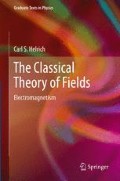Abstract
In this chapter we obtain the mathematical equations which completely describe the electrostatic field from the results of a single experiment: that of Coulomb. Because of the mathematical form of Coulomb’s Law the formulation of the electrostatic field will emerge in a natural fashion, although it is a philosophical step. We will introduce a superposition Ansatz to cast the results of Coulomb’s Experiment in terms of distributions of charges. And from these we will be able to find the divergence and the curl equations required to specify the field according to Helmholtz’ Theorem (see Sect. 2.6.1).
Access this chapter
Tax calculation will be finalised at checkout
Purchases are for personal use only
Notes
- 1.
Empirical results are those obtained from laboratory measurements. The mathematical equation the experimenter obtains to represent the data in terms of known or defined and measurable quantities is the empirical equation describing the experiment.
- 2.
The German term Ansatz, which has entered American physics and mathematics, means that we are going to consider a certain construct or point of view to be correct and shall seek results consistent with this construct. In effect the Ansatz defines the world we consider. Lack of agreement with experiment would force us to consider a new Ansatz.
Author information
Authors and Affiliations
Corresponding author
Rights and permissions
Copyright information
© 2012 Springer-Verlag Berlin Heidelberg
About this chapter
Cite this chapter
Helrich, C.S. (2012). Electrostatics. In: The Classical Theory of Fields. Graduate Texts in Physics. Springer, Berlin, Heidelberg. https://doi.org/10.1007/978-3-642-23205-3_3
Download citation
DOI: https://doi.org/10.1007/978-3-642-23205-3_3
Published:
Publisher Name: Springer, Berlin, Heidelberg
Print ISBN: 978-3-642-23204-6
Online ISBN: 978-3-642-23205-3
eBook Packages: Physics and AstronomyPhysics and Astronomy (R0)

